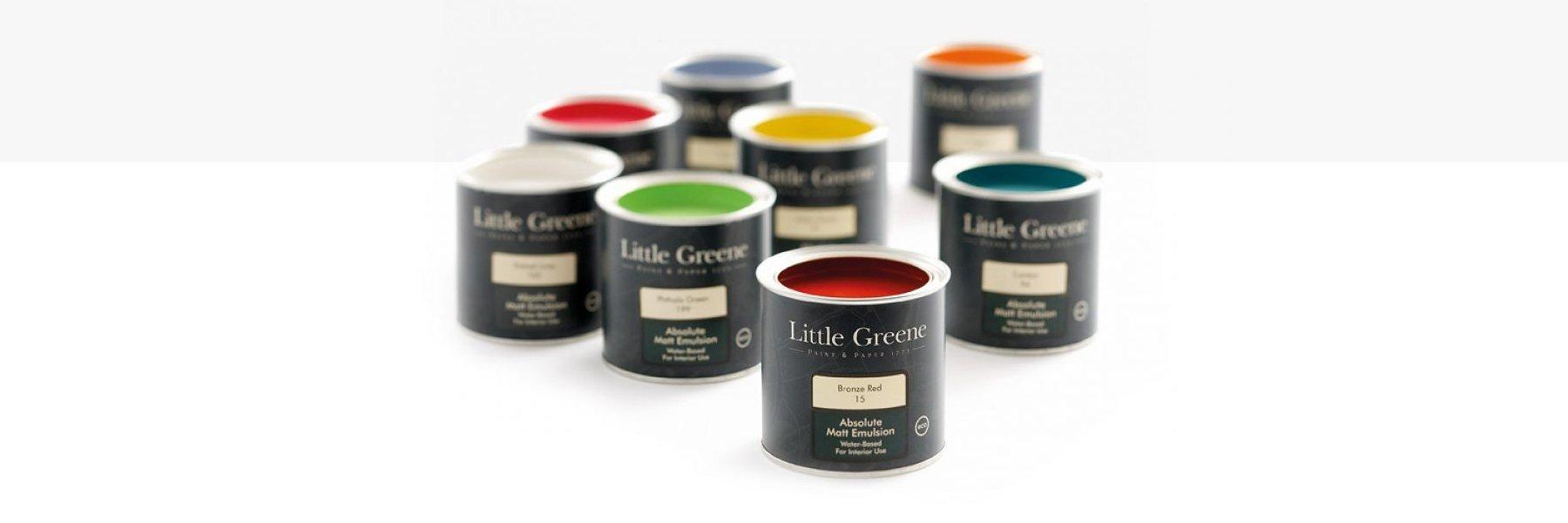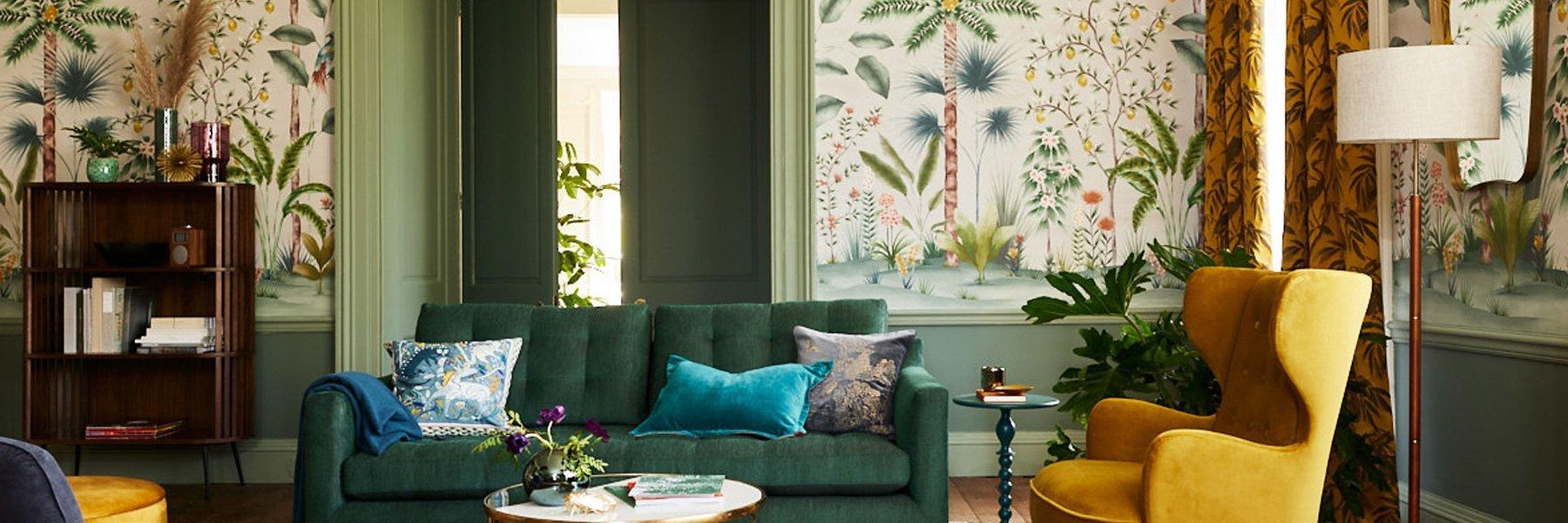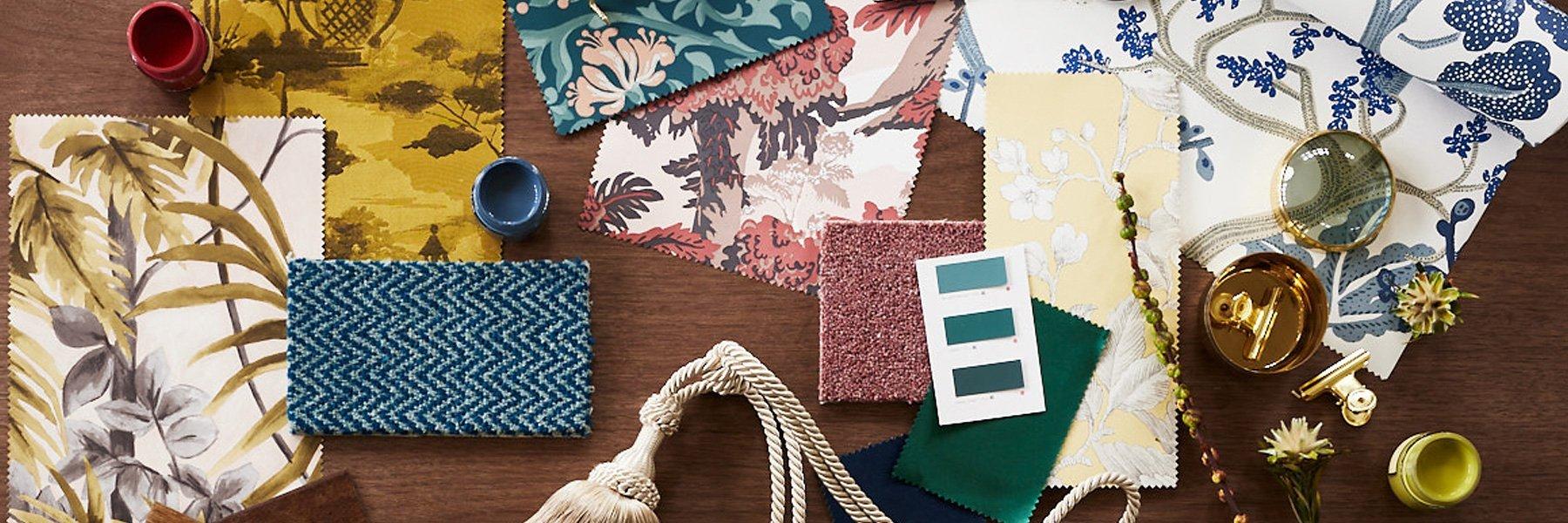Buying Guides

Buying Paint & Wallpaper
Paint: What sort should I buy?
Our quality paint comes from premium British brands, including: Little Greene Paint Co, Sanderson and COAT.
All of our paints are manufactured in the UK using the highest quality naturally occurring ingredients and are fully compliant with European Commission directives on harmful solvents. These premium paints give thorough coverage, with high pigmentation, great depth of colour and a beautiful flat finish that will make a real difference to your walls.
Colours
The appearance of colours will vary according to other paints, fabrics and lighting conditions in a room and even the time of day.
To help you make the right choice, apply a tester pot or peel and stick sample and observe the changing conditions in natural and artificial light.
Tip
Tester pots are available for all paints
Primer
A primer gives you a base coat that helps paint stick to the surface you're covering, so you use less paint and achieve better coverage.
It's most commonly used on wood or metal, but you should prime walls if you're painting onto bare plaster or brickwork, or whenever the wall is porous.
Brands
Little Greene paints:
- Are available in a comprehensive colour palette, incorporating both historic and contemporary shades
- Are designed to be gentle on the environment
- The Intelligent collection is completely child safe
Sanderson paints:
- Boast a colour palette of 140 subtle shades
- The Sanderson Collection is specially selected to work with Sanderson‘s renowned wallpapers and fabrics
COAT paints:
- Curated palette with 59 timeless shades
- Low VOC, water-based paint
- Vegan and child safe
- Climate Positive Certified & B Corp
- Made to order, zero waste production
Finishes
If you…
- Want a flat finish for your bedroom
Use COAT Flat matt paint, Little Greene Absolute matt emulsion or Sanderson matt emulsion
If you…
- Require a tougher, washable finish for hallways and children’s rooms
Then try Little Greene Intelligent matt emulsion
If you…
- Want a low sheen paint that will dry quickly for your dining room or woodwork
Then opt for Little Greene Intelligent eggshell or Sanderson water-based eggshell
If you…
- Then choose Little Greene water-based gloss. With an attractive, high-sheen finish, it's hard-wearing, quick-drying, environmentally friendly and can even be used outside.
Then choose Little Greene oil-based gloss

Wallpaper: What type should I buy?
Wallpaper is an effective way to achieve a new look with the minimum of fuss and expenditure. Modern wallpapers are incredibly easy to hang and come in a comprehensive choice of colours, inspirational designs and innovative textures.
If you're having your room wallpapered professionally, it’s a good idea to talk to your decorator before finalising your choice of paper.
Many of our bestselling wallpapers are created by John Lewis & Partners in our in-house design studio.
We also stock branded wallpapers from leading interior companies including Harlequin, Morris & Co, Sanderson and Zoffany.
All of these brands offer an eclectic mix of designs, ranging from cutting-edge contemporary to timeless classics drawn from extensive archives, so there’s bound to be something to suit your interior style.
Light and colour
- When selecting wallpaper, it's best to order a sample to try out on different walls and to see how it looks at various times of the day or night
- You need to take into account the kind of light you get in the room, as darker spaces benefit from warmer tones. Don’t forget to look at the paper in artificial light, as this will differ from natural light
- When you have chosen your wallpaper, check the labels on the rolls all carry the same batch number as colours can vary slightly from batch to batch
Types of wallpaper
If you…
- Are wallpapering alongside traditional décor in your dining room or living room
Then consider plain or textured wallpaper because…
- It can be used to great effect to set off the rest of your room’s features
If you…
- Want wallpaper that will make an impact
Then opt for patterned wallpaper because…
- It can create a bold feature wall and add drama to a room without huge outlay
If you…
- Are decorating a ‘high-splash’ zone such as a kitchen, bathroom, playroom or nursery
Then consider vinyl or washable wallpaper because…
- It can be easily wiped down
Alternative uses for wallpaper
Wallpaper is an incredibly versatile decorating tool. Here are some ideas on how to use up your spare pieces:
- Liners for drawers
- Canvases
- Framed pictures
- Wardrobe panels
- Front facing of staircases
We also stock wall murals and panel sets, which make for an eye-catching wall covering or feature wall.
The bigger picture
If you need advice with your decorating project in terms of choosing colours and matching furnishings, our stylists will be happy to help.

How much do I need?
To calculate how much paint or wallpaper you need, you should work out the square footage of the room you wish to decorate using the following formula:
Length of all walls x room height from floor to ceiling
- Paint usually comes in 2.5 or 5-litre tins – you could expect 1 litre of emulsion paint to cover approximately 12 square metres (129 square feet)
- Standard wallpaper rolls measure approximately 10.05 metres (11 yards) in length and are 52 centimetres (20.5 inches) in width
- Wide wallpaper rolls measure 68.5 centimetres (27 inches) in width
Simply divide the total number of drops needed for the room, by the amount of drops achievable from a roll. This figure is the total amount of rolls needed.
For designs with a pattern repeat of up to 26cm add 10% up to the nearest full roll, for wastage. For designs with a pattern repeat of over 26cm add 15-20%.
Wallpaper roll calculator
| Calculating the number of rolls needed | ||||||||||||||||||
| DISTANCE AROUND THE ROOM (INCLUDING DOORS AND WINDOWS) | ||||||||||||||||||
| Height from skirting | 9m (30') | 10m (34') | 12m (38') | 13m (42') | 14m (46') | 15m (50') | 16m (54') | 17m (58') | 18m (62') | 19m (66') | 21m (70') | 22m (74') | 23m (78') | 24m (82') | 26m (86') | 27m (90') | 28m (94') | 30m (96') |
| 2.15-2.30m (7'-7'6'') | 4 | 5 | 5 | 6 | 6 | 7 | 7 | 8 | 8 | 9 | 9 | 10 | 10 | 11 | 12 | 12 | 13 | 13 |
| 2.30-2.45m (7'6''- 8'') | 5 | 5 | 6 | 6 | 7 | 7 | 8 | 8 | 9 | 9 | 10 | 10 | 11 | 11 | 12 | 13 | 13 | 14 |
| 2.45-2.60m (8'- 8'6'') | 5 | 5 | 6 | 7 | 7 | 8 | 9 | 9 | 10 | 10 | 11 | 12 | 12 | 13 | 14 | 14 | 15 | 15 |
| 2.60-2.75m (8'6''-9') | 5 | 5 | 6 | 7 | 7 | 8 | 9 | 9 | 10 | 10 | 11 | 12 | 12 | 13 | 14 | 14 | 15 | 15 |
| 2.75-2.90m (9'-9'6'') | 6 | 6 | 7 | 7 | 8 | 9 | 9 | 10 | 10 | 11 | 12 | 12 | 13 | 14 | 14 | 15 | 15 | 16 |
| 2.90-3.20m (9'6''-10'') | 6 | 6 | 7 | 8 | 8 | 9 | 10 | 10 | 11 | 12 | 12 | 13 | 14 | 14 | 15 | 16 | 16 | 17 |
| 3.05-3.20m (10'-10'6'') | 6 | 7 | 8 | 8 | 9 | 10 | 10 | 11 | 12 | 13 | 13 | 14 | 15 | 16 | 16 | 17 | 18 | 19 |
| Ceilings | |||||||||||
| Distance around the room | 8.5m | 12.1m | 14.6m | 17.6m | 20.0m | 21.3m | 23.7m | 25.0m | 26.8m | 28.0m | 30.5m |
| Number of rolls required | 1 | 2 | 3 | 4 | 5 | 6 | 7 | 8 | 9 | 10 | 12 |
For optimum results, ask your decorator for advice on the type of paint or paper best suited to your walls.
If you're doing the job yourself, don’t be daunted. Our calculation chart helps you work out the number of wallpaper rolls required.
Tip
Make sure you buy enough wallpaper to manage your pattern repeat. If
you need extra wallpaper at a later date, there can be subtle shade variation between batches.
JOHN LEWIS VISUALISER
Upload a photo of your own room and choose from a selection of wallpaper styles to see in your own home
The bigger picture
If you need advice with your decorating project in terms of choosing colours and matching furnishings, our stylists will be happy to help.

Delivery options
We offer a range of delivery options.
Free standard delivery
All of the wallpapers we stock will come to you via our Standard delivery to your home, which is free when you spend £50 or more.
specialist delivery
When you order paint and certain wallpapers online, please note that they’ll come direct to you from the supplier via specialist delivery and won’t be available to Click & collect from our shops.
Do it yourself
Top tips for painting
- Roll up rugs, move furniture to the centre of the room and cover before getting started
- Loosen wall sockets and remove switch plates, door and window fittings so you can paint around neatly
- Stir paint thoroughly before use
- A clean plastic food-storage container with a tight-fitting cover is ideal for emulsion paint; a metal can is better for oil based paint
- Choose the right brushes for the type of paint you're using: straight-edged brushes are most versatile, but angled brushes can be more comfortable in tight spots and are good for painting trim and straight lines
- Work from the ceiling downwards
- Mix eggshell paint thoroughly to avoid varying sheen levels when dry
- Only apply sufficient paint to maintain a wet edge and apply even coats over the entire surface to avoid overlap marks
- When painting windows, try not to lay on paint too thickly; if they’re sash windows, slide them up and down during the job to stop them from sticking shut
- Where possible, leave windows open for at least 24 hours while drying
- Keep paint tightly sealed in its original container, away from extreme temperatures, when not in use. Sheds, garages and basements may get too cold, which could cause paint to deteriorate in quality
Drying times
If you:
- Are using water-based paints
Then you should allow 1-2 hours' drying time and 3-6 hours between coats
Tip
You'll usually need to apply 2 coats to get best results
If you…
- Are using oil-based paints
Then allow 4-6 hours' drying time and 12-16 hours between coats
Cleaning up
If you:
- Are using water-based paints
Then rinse brushes and rollers thoroughly with water until it runs clear and all paint is removed from bristles.
Press dry with kitchen roll or paper towels and ideally store hanging up
Tip
If you're going to apply a further coat, wrap the brush or roller in a plastic carrier bag until you start work again, so that it doesn't dry out.
If you:
- Are using oil-based paints
Then you'll need to use white spirit or specialist brush cleaner
Check your local authority’s waste disposal guidelines for advice on how to dispose of paint cans, waste paint and cleaning solvents responsibly.
Top tips for wallpapering
- Make sure your walls have a smooth surface before starting
- Lining paper will help prevent your wallpaper from shrinking or wrinkling
- Take the rolls out of their wrapping and inspect them in natural light to make sure they're all exactly the same hue
- Keep an eye on the closeness of the colour match once the paper is going up
- Always use the correct paste as recommended by the manufacturer, as this will make the difference between successful hanging and a disappointing result
- Make sure the design is hung in the correct direction; refer to your sample to see which way up the paper should go. Reverse hanging is common on vinyls as they are printed wide width then halved. Reverse hang wallpaper means every strip of wallpaper must be installed in opposite directions from how it comes off the rolls, this avoids shading variances.
Tip
If at any time you have concerns over colour consistency, stop using the paper and contact the wallpaper company's customer services department with details of your order number, design and batch numbers to hand
